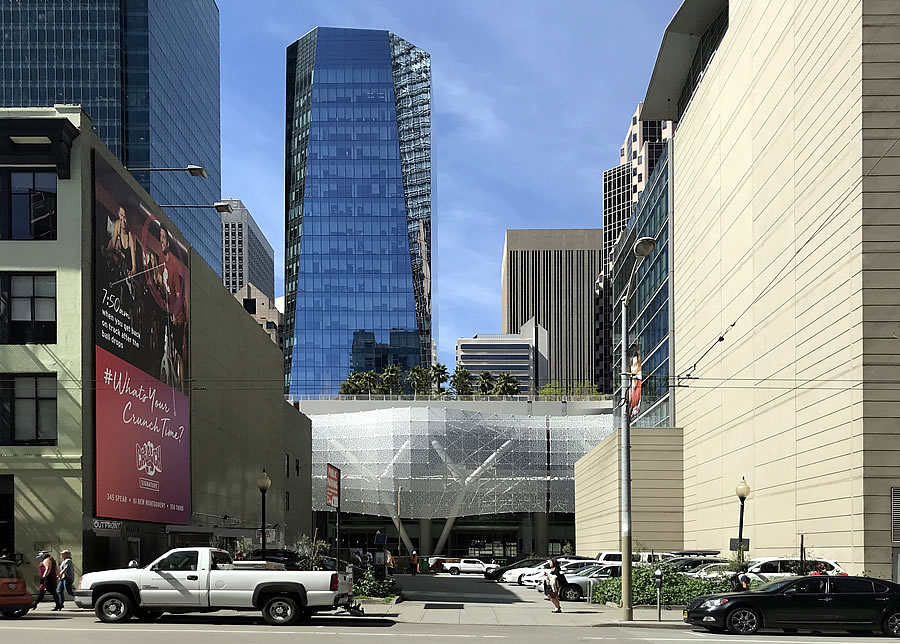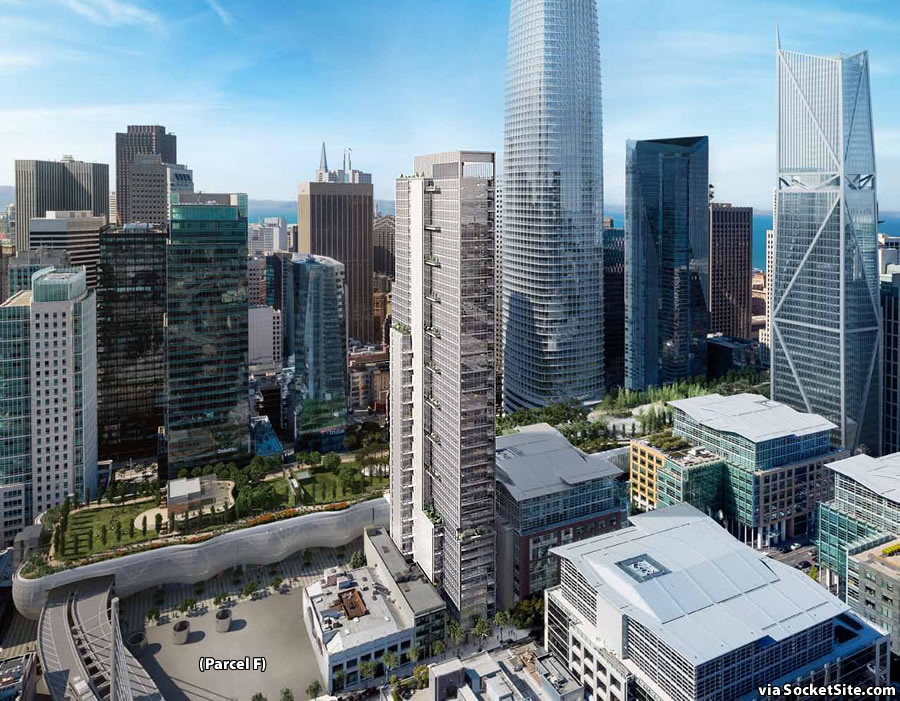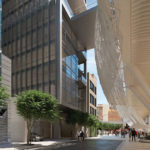Plans to redevelop the downtown parking lot parcel at 524 Howard Street were first approved nearly three decades ago, at which point a 23-story office building was expected to rise up to 311 feet in height after the former parking garage on the site was razed in 1989.
But following an ongoing series of false starts and delays, the now surface parking lot parcel ended up being foreclosed upon in 2011 with over $23 million owed and sold to Crescent Heights for $15.85 million in 2012.
In 2013, Crescent began touting plans for a skinny 44-story residential tower to rise up to 450 feet in height upon the parcel, plans which were to be “coming soon.”
In early 2016, Crescent Heights added another 4 stories to their plans, for a total of 48 stories and 495 feet, and secured a two-year extension for the operation of the parking lot at 524 Howard Street, the operation of which is technically a temporary use, in order to provide the development team with a window within which to secure approval for the additional height.
By the end of 2016, the plans for a 495-foot-tall tower with up to 334 condos, or 72 condos over a 273-room hotel, depending upon market conditions, were approved and plans to connect the tower to the adjacent Transbay Terminal rooftop park were drawn.
And with the 2016-era extension for the temporary parking lot at 524 Howard Street slated to expire next month, Crescent Heights is now seeking another extension to continue the parking lot’s operation for another two years.
Keep in mind that Crescent Heights’ entitlement to break ground for its approved 495-foot-tall tower is slated to expire in the fourth quarter of 2019. We’ll keep you posted and plugged-in.




“The Coming Condo Slowdown”: please submit your 500 word essays c/o this address. Winner to receive a ticket to the groundbreaking (Date: mm-dd-20XY)
Too bad, this was one of the more interesting ones.
Looks like they are gonna hold it through the next downturn. By 2020 or 2021 as the market picks up again this site maybe will become a skinny 800 -1000 ft tower at play? Built by 2023? Maybe?
One can dream right? Other than that I can’t see why they are sitting in this forever.
This lot is such an eyesore. The potential is huge though.
I meant built by 2023
@Notcom Can I win a one-way ticket to Seattle instead?! Kidding aside, this project has been one to watch and the delay by Crescent isn’t a surprise. The numbers must be dicey given the fact it wasn’t started during the boom times of a few years ago. At this point it likely doesn’t pencil at all given rising interest rates, the slowing of the SF/BA job market (with potentially a drop in SF’s population over the coming 5 years IMO) and the flattening of new condo prices in SF. Not to mention the ongoing rise in construction costs. Note that the lease is extended beyond the 2019 date by which time construction must start. That tells me Crescent will put the entitlement up for sale in the coming year and is actively pursuing the best deal/exit. Possibly shifting the money from the sale to a more lucrative condo tower project in downtown Seattle?
It begs the question – who might purchase the entitlement given the economic situation? Perhaps a developer who will build out a smaller hotel project? With it’s location next to the so-called TTC, a medium sized hotel just might pencil. Basically, drop the 25 stories of condos from the Crescent project and build a 20 story hotel. This has been a project to watch as a gauge of future SF development as I’ve noted. Another project to watch? Parcel F. The developer paid a bundle for the site and faces the same economic headwinds/issues as this project. Don’t be surprised if the Parcel F project is significantly scaled back in size. Perhaps eliminate or reduce the condo portion. I’d love to see the numbers on the Parcel F project.
Maybe you can win a raincoat and a flu shot for your move.
Raincoat and flu shot? Cute.
Keep up the Seattle rain, rain, rain stereotype. It keeps naysayers and wannabe NIMBYS away.
No it doesn’t. Fastest rising housing prices of any major metro area in the country.
That despite crazy insane residential construction. 10K market rate apartments opened in 2017. 12K should open this year. Seattle is doing everything it can to hold rising rents and housing costs in check. In SF projects are not being delayed/possibly dropped as the Crescent project is and as several other large projects have been. In Seattle they can’t be approved fast enough. Two different worlds and much of it is the result of years of failing to address the housing crisis in SF and the BA.
Well if it’s true that Seattle has the fastest rising housing prices of any major metro area in the country and housing projects are being approved as fast as they can be proposed, then what does that say about the arguments of the supply siders on socketsite who claim that increased supply would reduce prices and that it’s simple Econ 101?
From earlier this afternoon, You Can Learn a Lot About an American City by Who’s Leaving It:
“Take Seattle…even after all this construction, Seattle’s share of cost-burdened renters (the percentage of tenants who pay more than 30 percent of their income in rent) is very high, 46 percent. That makes Seattle look less affordable than San Francisco, in 2017 data.” (Emphasis mine, to draw the connection to the topic of discussion.)
The Harvard web site at the end of the final link says that the share of cost-burdened renters in the “San Francisco-Oakland-Hayward” metro area is 45.6 percent; I’d call that pretty much equal.
” then what does that say about the arguments of the supply siders on socketsite who claim that increased supply would reduce prices and that it’s simple Econ 101?”
I’d say that have causality backwards and that it’s the rising prices and incoming residents (or the expectations thereof ) that incentivize supply to come on-line.
It’s never simple Econ 101 – really more like Econ 1 – since the Supply and Demand curves aren’t independent of one another: building more housing allows more companies – often untethered from the reality of having to make a profit – to hire more and more people…which just shifts the demand curve out further. If you want the market to “work”, stop building housing, and it will become so expensive that companies like Linkedin and Square – or even cash furnaces like Uber won’t be able to pay people enough.
Interesting article. Note that the “leftists” used a different metric from the one used that came up with the one used to say that rents have been tamed. Dueling agendas? In any case the median Seattle income is 82K and the median SF income is 92K. The median 1 bedroom rents for $1970 and the median two bedroom rents for $2675. In Seattle – as of last month. The corresponding SF number are $3781 and $4431 as of last month. Seattle is significantly more affordable based on those numbers. Also, the median home price is about half a million less in Seattle than in SF..
“building more housing allows more companies – often untethered from the reality of having to make a profit – to hire more and more people…which just shifts the demand curve out further.”
What this is really telling you is that price momentum can easily swamp supply. Or to put it another way: You can’t supply your way out of a bubble.
It’s not the amount of housing that sustains these companies, but the amount of buyers (or perceived buyers) of their stock. During time periods of exuberance people will buy into money losing stocks with little to no questions asked simply because they expect growth. i.e. Just buy in at $1B valuation in the hopes of getting out at $5B. Who wouldn’t want that? As long as valuations keep rising, people keep buying and if people keep buying companies keep getting created or grown.
Same reason that housing supply seems to have no effect during the up-slope of very large housing cycle. Who wouldn’t want to get into a $1M condo they believe will rocket up to $2M?
And as the focus on growth increases, focus on quality decreases. The quality of the condo or company you are buying into becomes secondary its expected financial return. Reduced focus on quality eases supply constraints. It’s easier to create poorly designed and built units than it is to create quality. Similarly it’s easier to create shoddy money loosing companies than it to create solid sustainable ones.
I have lived in the Seattle Climate in the past – not for everyone, and definitely not for me 🙂
Seattle’s annual average rainfall is 37 inches/year. 152 average rainy days/year. It is not a stereotype.
Seattle better hope that Trumps attacks on Amazon don’t go anywhere. The growth in its economy is basically two companies. If one of them has problems, Seattle has problems.
It is a shame that this project is delayed but understandable. The developers might have been betting on CAHSR and Caltrain’s DTX projects to bring rail to the Transbay earlier. DTX alone would significantly increase the value of residences on this site but that’s not gonna happen until the mid 2020s at the earliest.
Not generally a fan of skinny skyscrapers built on soft mud in earthquake country – but walking around down there last week I have to say the Transbay District overall is shaping up nicely.
^— Everyone is an armchair structural engineer.
Thank you for your input.
UPDATE: Placeholder for Transbay District Tower Slated for Approval, Again